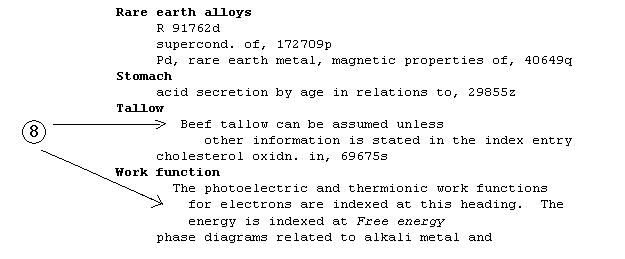Teaching Chemical Information:
Tips and Techniques
— March 1998 —
Chemical Abstracts: Illustrative Key to General Subject Index Entries


- The index heading appears in boldface. It may or may not include a homograph definition, a heading subdivision, or (in italics) a synonym (see below for an explanation of these terms).
- The modifier appears in boldface following the General Subject Index heading and provides additional specificity for the index heading.
- The heading subdivision (qualifier) appears in boldface following a comma. It is used primarily to organize index headings with large numbers of entries into groups with a single topic in common. Further details of the types and scope of subdivisions are to be found in the 1994 Index Guide, Appendix II, ¶10B. (complete listings of subdivided General Subject Headings are included in that Appendix.)
- The homograph definition appears in boldface in parentheses. It differentiates between identical or closely similiar index headings possessing distinct meanings (see the 1994 Index Guide Introduction, ¶7).
- The synonym appears in italics in parentheses. In this index it normally supplies a genus-species appelation at a common-name index heading for a plant or animal.
- The index modification appears in lightface, briefly adding further information pertaining to the index heading.
- The reference is to the sequentially numbered CA abstract. The final
character is a check-letter which allows computer validation of the numerical part of the
reference. Three types of source documents are identified by capitalized code letters
preceding the reference; these code letters are:
- B — for books (including textbooks, handbooks, and encyclopedias) and audio-visual materials;
- P — for patents;
- R — for reviews.
- The indexing note explains the policies adopted at each of numerous headings. At chemical class names, e.g., Amines, Ketones, nomenclature policies are summarized. At many other headings, including the common and scientific names of animals and plants, assumptions made by indexers or to be made by index users are detailed. (The Tallow example above is such an assumption note.) At many index headings, including Work function above, notes define precisely what information has been included and what placed at related headings. See also the 1994 Index Guide Introduction, ¶6.